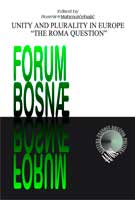ROMA AND EDUCATION: EXAMPLES FROM SWEDEN
ROMA AND EDUCATION: EXAMPLES FROM SWEDEN
Author(s): Charles WestinSubject(s): Social Sciences
Published by: Međunarodni forum Bosna
Keywords: swedish Roma; Finnish Roma; Non-Nordic (European) Roma; Structural Discrimination; integration policy
Summary/Abstract: [...] The first historically established references in Swedish public records relating to “Gypsies” (zigenare) are from the mid-16th century. The records make it quite clear that these people with their wagons were not allowed to settle for more than a few days at a time in any one place and thus were compelled to be on the move. They made their livelihood through trading, taking on various unclean jobs, but also serving as entertainers, musicians, fortune- tellers, etc. Common to these references is that the “Tatars,” as they were then called, were unwanted and undesired in the towns and villages they passed through. In the early 17th century, several decrees were issued by the state to the effect that Roma people were expelled from central Sweden to the eastern parts of the country (present-day Finland). By and large, the Finnish Roma population descends from groups expelled from central Sweden several hundred years ago. Many have Swedish surnames. A theory presented by the ethnologist Allan Etzler (1944) is that descendents of the first Roma in the 16th century also constitute the origins of the travelling community in Sweden. Although challenged by other ethnologists (Heymowski 1969), many present-day Travellers support Etzler’s hypothesis. Travellers used to speak a secret language referred to as Rommani. Only a few native speakers are still alive. The Travellers used to be known as “tattare,” a derogatory word derived from Tatar. They were an out-caste group in rural society. A competing hypothesis about their origin is that they derive from various socially-excluded groups in rural society, such as hangmen, horse-dealers, knackers, prisoners of war, foreign mercenaries, possibly also including dispossessed Saami whose territories in the forest regions of north-central Sweden were gradually colonized by Swedish farmers. [...]
Journal: Forum Bosnae
- Issue Year: 2008
- Issue No: 44
- Page Range: 173-193
- Page Count: 21
- Language: English
- Content File-PDF

